Medieval Radiance: The Vase of Eleanor and Suger’s Vision
Dive into Royal Goldsmithing: A Tale of Brilliance and Influence
Faluns of Anjou Arts
At the crossroads of history and art, the vase of Queen Eleanor of Aquitaine invites us on a journey through time, revealing Abbot Suger as one of the most influential figures in the kingdom of France. This exceptional object also bears witness to the mastery of French goldsmithing, a tradition of excellence that has endured for centuries.
Context:
What is the origin of the name of Eleanor of Aquitaine’s vase?
Eleanor of Aquitaine, an emblematic figure of the Middle Ages, was the daughter of William X, Duke of Aquitaine, making her one of the most significant heiresses of her time, with lands covering the center and southwest of present-day France. Her marriage to Louis VII initially expanded the French realm, but marital discord and Eleanor’s fiery temperament, including notorious infidelities, led to divorce. Her remarriage to Henry Plantagenet, the future King of England, resulted in the transfer of Aquitaine under the English crown. In the art world, Eleanor’s name is associated with a remarkable piece composed of two elements from different periods and origins: a rock crystal vase and a precious gilt silver setting.
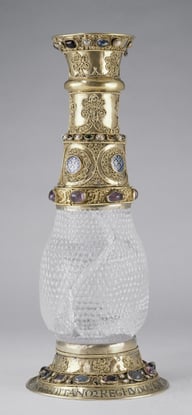





A rock crystal vase and its gilded silver mount
Technique: Goldsmithing, Niello, Filigree, Champlevé Enamel
Materials: Rock crystal, Gold (metal), Pearl, Enamel, Precious stone
Dating: Vase: Sasanian dynasty, 500-700 - Mount: 1137-1140, 13th-14th century
Location of conservation: France, Paris, Louvre Museum
From Iran to Saint-Denis
An epitaph on the base narrates the vase’s storied journey: Given to King Louis by his wife Eleanor, from Mitadolus to his forefather, from the king to Abbot Suger of Saint-Denis. He dedicated this vase to the patron saints Denis, Rusticus, and Eleutherius, venerated in his abbey. Received from Louis VII, who in turn had received it as a gift from Eleanor, she had inherited it from her grandfather, Duke William IX of Aquitaine, who had acquired it from Mitadolus. This enigmatic figure likely corresponds to the ruler of Zaragoza, whose Arabic name Imad al-dawla, translated into Latin as Mitadolus, indicates a noble origin. Allied with William IX around 1120, it is plausible that he bestowed this vase as a diplomatic gesture. Such gifts traveled between nations, each new owner enhancing it with a personal touch.
The vase is made of rock crystal, a type of transparent and colorless quartz that requires great skill to work, from carving the stone to creating the decor that enhances its value. It features a so-called honeycomb pattern, with hexagonal facets aligned precisely, a style already appreciated in ancient Rome, then in Byzantium and the Middle East, especially under the Sassanids (224-642) in Iran and Mesopotamia. The opulence of Sassanid silver and glassware strengthens the attribution of this vase to that era.
Suger: (1080/1081-1151) Advisor to Louis VI and Louis VII, Abbot of Saint-Denis. He is considered the initiator of the Gothic style in France with the renovation of the Saint-Denis basilica.
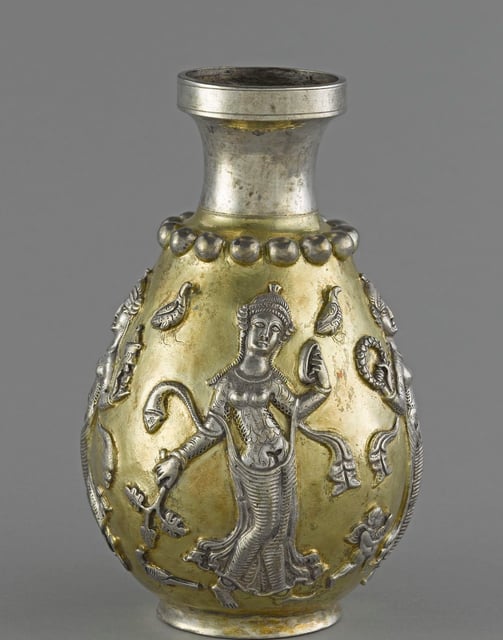

Image 3:Vase from the Sasanian art, known for its luxurious silver and glass tableware.
How do Eleanor of Aquitaine’s vase and the persona of Abbot Suger reflect the prestige and significance of French cultural heritage, and in what way does the mount of this vase showcase the unparalleled craftsmanship of French goldsmithing of that era?
I. Abbot Suger: Architect of the Grandeur of the Kingdom of France
Suger of Saint-Denis, a pillar of French royalty
Leading the Abbey of Saint-Denis from 1122 until his death in 1151, Suger emerged as a pivotal advisor to Kings Louis VI and Louis VII, even playing a crucial role in the governance of the kingdom during the Second Crusade (1147-1149). He bolstered the stature of his abbey, the royal necropolis, by closely associating it with France’s patron saint, Denis.
His impact extended to the arts, with Suger initiating the transformation of the Basilica of Saint-Denis into a precursor of Gothic style, marked by splendid stained glass windows. Despite criticism from Bernard of Clairvaux, a staunch advocate for austerity, Suger championed opulence as a means of spiritual transcendence, elevating aesthetic pleasure to an almost mystical experience worthy of divine majesty. He enlisted the skills of goldsmiths, particularly from the Île-de-France region, credited with creating Eleanor’s vase’s mount. At that time, abbeys were hubs of artistic creation, and abbots were true art patrons.
Gothic Art: A style that developed from the mid-12th century to the early 16th century in the Christian West.


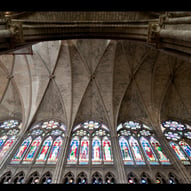
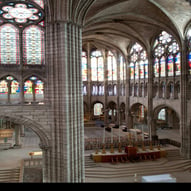
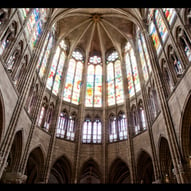

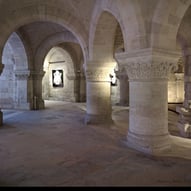
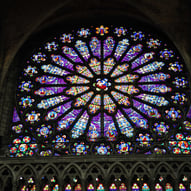
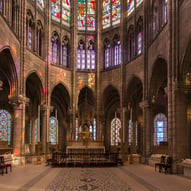
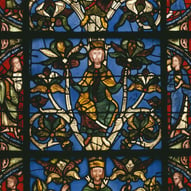
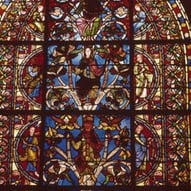
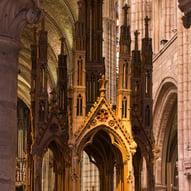
Abbot Suger
Basilica of Saint-Denis
Basilica of Saint-Denis, interior of the Nave
Basilica of Saint-Denis, partial view of the north transept, with the apse in the background
Apse of the Basilica of Saint-Denis 1
Apse of the Basilica of Saint-Denis 2
Crypt of the Basilica of Saint-Denis
Stained glass of the Basilica of Saint-Denis
The Rose
Chevet of Abbot Suger, circa 1144
Basilica of Saint-Denis, stained glass window of the Tree of Jesse (detail: second king)
The relics of Saint Denis, Rusticus, and Eleutherius under a 14th-century canopy.
II. The Mount: A Benchmark of French Goldsmithing Excellence
Sumptuous ornamentation : The pinnacle of French goldsmithing
In his writings, Abbot Suger recounts the embellishment he commissioned for this rock crystal vase, adorning it with gold and gems to enhance its brilliance. Its mount, made from gilded silver, is noted for the sophisticated use of filigree, with metal wires carefully soldered to create intricately beaded patterns that stand out strikingly against the smooth, gleaming metal. This ornamental style, rare for the period, may have been inspired by Eastern pieces. Embedded pearls and precious stones add a vibrant chromatic dimension. Other goldsmithing works commissioned by Suger feature similar decorations, showcasing the skill of craftsmen he frequently employed.
The vase underwent several modifications over time, including the addition of enamelled medallions adorned with fleur-de-lis in the 14th century. By enriching the treasury of the Abbey of Saint-Denis with this and other lavish offerings, Suger aimed to elevate Saint-Denis to one of the foremost places of worship in Christendom. Although the French Revolution led to the destruction of many treasures of Saint-Denis, significant pieces like Eleanor’s vase were preserved and are now housed in the Louvre Museum and the National Library.
Treasure: The term refers both to a collection of precious objects and the place that houses them.
Filigree: A goldsmithing technique that involves creating a decoration from intertwined and soldered metal wires on a base.
Enamel: A colored varnish, opaque or translucent, that can be applied to various materials (ceramic, metal, stone, glass…).
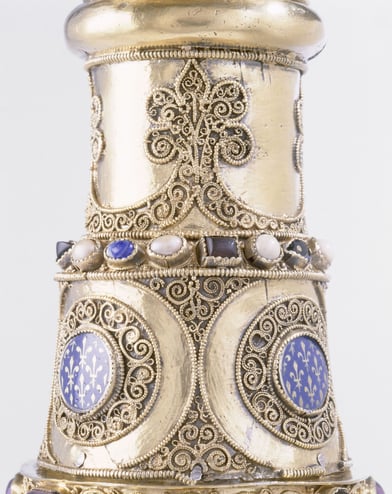
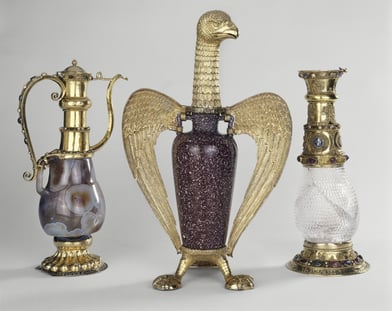


He had elegant, highly decorative beaded fleurons designed.
The vase of Queen Eleanor and Abbot Suger stand as pivotal elements in understanding the cultural and artistic influence of medieval France. They symbolize not just political power but also the artistic refinement of this significant era.
Examining the vase of Queen Eleanor and its historical context enhances our appreciation of French art history, providing insights into the skills, influences, and innovative spirit of the time.
Dive into the fascinating history of French artistic heritage by rediscovering the vase of Eleanor of Aquitaine and the indelible impact of Abbot Suger on the art and culture of his era.
#EleanorVase #AbbotSuger #FrenchGoldsmithing #FrenchHistory #MedievalArt #CulturalHeritage #HistoricalCraftsmanship
The Queen Eleanor of Aquitaine
The Eagle of Suger is a porphyry vase embellished with a gilded silver mount shaped like an eagle with spread wings. It was created in the 1130s-1140s, under the orders of Abbot Suger, by Parisian goldsmiths using an antique vase.

